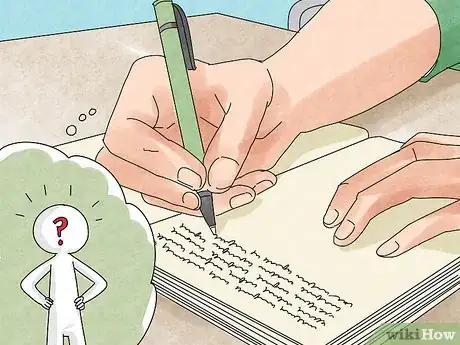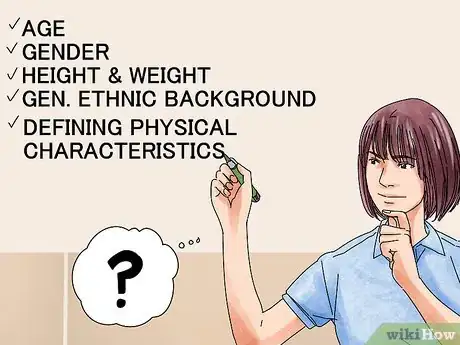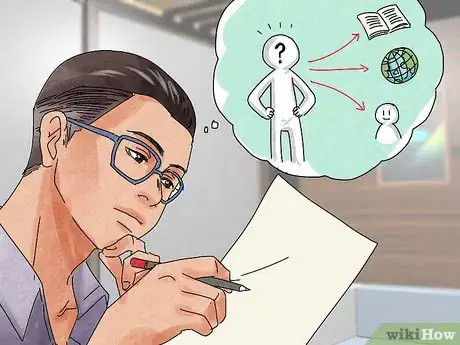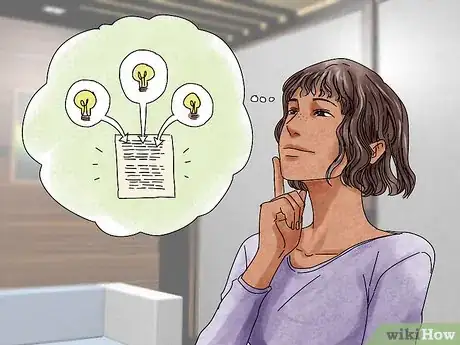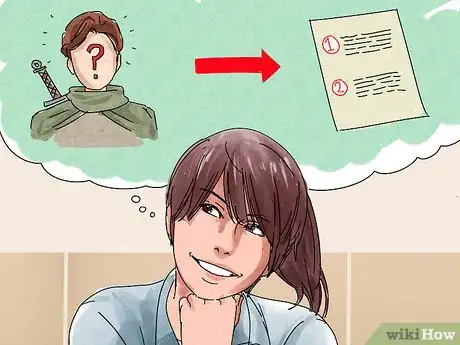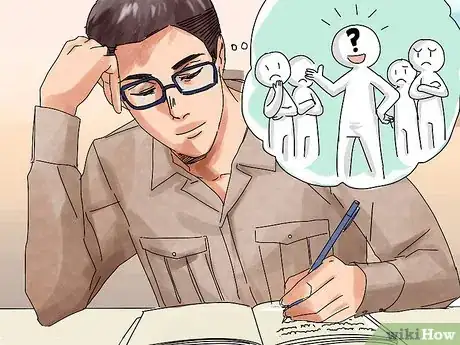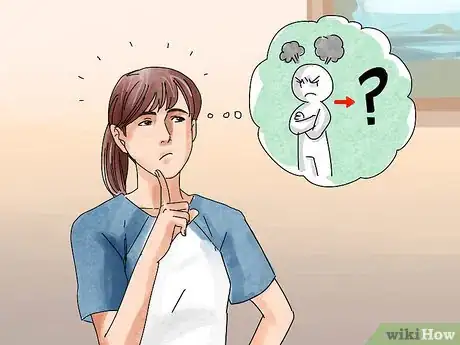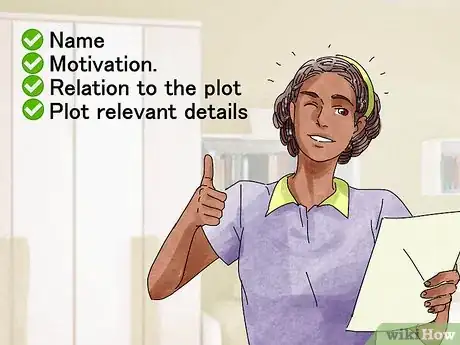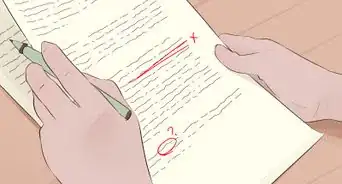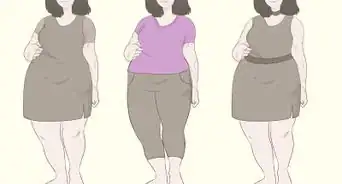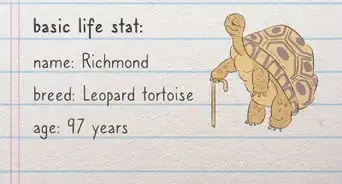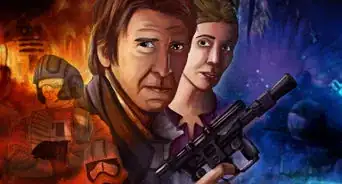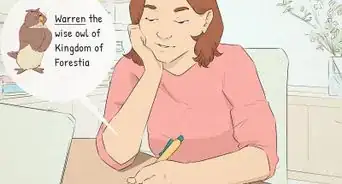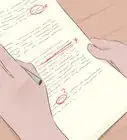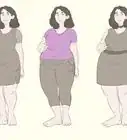This article was co-authored by Grant Faulkner, MA. Grant Faulkner is the Executive Director of National Novel Writing Month (NaNoWriMo) and the co-founder of 100 Word Story, a literary magazine. Grant has published two books on writing and has been published in The New York Times and Writer’s Digest. He co-hosts Write-minded, a weekly podcast on writing and publishing, and has a M.A. in Creative Writing from San Francisco State University.
There are 11 references cited in this article, which can be found at the bottom of the page.
wikiHow marks an article as reader-approved once it receives enough positive feedback. This article has 13 testimonials from our readers, earning it our reader-approved status.
This article has been viewed 258,659 times.
Character sketches are guidelines, explorations, and even short stories that are essential for writers in any form. You want to develop a consistent, realistic character early on so that you know how they would behave in any situation. The best stories feature characters that drive the plots, not plots that drive the characters, but that is only possible if you know who your characters are.
Steps
Brainstorming Characters
-
1Free-write about your character to get started. There is no right way to begin a character sketch because characters can pop into your head in any number of ways. You might see their physical appearance first, you could think of a profession or character type you want to use, or you could decide to base a character on someone you know. When designing characters, set aside some time to let your imagination run, finding your initial image of the character and taking off from there.
- You aren't bound to any of these initial sketches -- you could very easily throw them all out. Like all brainstorming exercises, the point is to start searching for ideas you love.[1]
-
2Confirm the basic physical description of the character. It is far easier to think in visual, concrete terms than put together abstract concepts like "friendly," or "intelligent." Most writers, and readers, generally need some sort of image of the character that they can relate to. If you're artistically inclined, you could even draw out the basics of your character first.[2] Even if the description is sparse ("young, white male") in the final book, movie, or play, a character sketch may include:
- Approximate age
- Gender
- Approximate height and weight
- General ethnic background (ie. "tall, blonde Scandinavian-type")
- Defining physical characteristics (hair, beauty, glasses, typical clothing, etc.)
Advertisement -
3Think about your character's overall emotions and feelings. Complex characters display a wide range of emotions, but almost all characters can be simplified to 1-2 base feelings. Overall, how does your character view life: optimistic, greedy, humorous, angry, oblivious, thoughtful, timid, creative, analytical? You want a simple guidepost when writing out the character -- a jumping off point that allows you to explore the other, more complex emotions when you start writing.
- How do they deal with hardship? Are they powerful or weak in the world? Do they make themselves vulnerable, or are they invulnerable?
- What makes them happy? Sad? Angry? [3]
- Sometimes authors put their characters through the lens of psychological profiles—e.g., whether they're extroverted or introverted.
-
4Come up with a name for your character. Sometimes the name comes easily. Sometimes it is the hardest part of the character to nail down. While names can change throughout the writing process, there are a couple different avenues you can take when naming characters:[4]
- Search the internet for baby names websites such as Behind the Name or Nameberry. Most of these websites categorize the names by ethnic origin as well, such as Japanese, Arabic, French, Russian, Hawaiian, Hindi, etc.
- Choose meaningful names. While this has fallen slightly out of fashion for modern literature and film, there is a rich history of sly or meaningful character names. See The Scarlett Letter, or Arrested Development for variously humorous or insightful names.
-
5Determine the character's relationship to the story, world, or main character. Why is this character important to your book or novel?[5] If you're writing a character sketch about someone it generally means they are vital to your story, since minor characters rarely require a character sketch. What is their relationship to the protagonist? How do they get involved in the story? How do you see them contributing to the novel?
- Again, this doesn't have to be set in stone necessarily. Many writers use this space to brainstorm possible plots, conflicts, or uses the character might have.
-
6Develop your character's backstory. It gives your character depth, so that the reader understands more about where they are coming from. Where did they grow up? What were their parents like? You may never use this information again, but you, as the writer, need to know these things to write a believable voice.[6] Simply thinking about their childhood tells you something about their accent, values, philosophy (or lack thereof), etc. If you're struggling to come up with a backstory, start with a simple question. How did the character get to where they are when the story begins?
- Think of friends or acquaintances similar to your character. What is their backstory? Read biographies or real-life character sketches for inspiration.
-
7Find your character's overarching motivation. The main thing is to know what drives your character, because in the story they aren't just a compilation of personality and physical descriptions. They are a soul moving through the world. What does your character want above all else? What guides them or pushes them to act? This can be their principles, their goals, their fears, or their duty. The best characters have agency. That means they take steps to get what they want instead of simply reacting to the world around them. This doesn't mean you can't have lazy or simple characters -- The Dude from The Big Lebowski just wants to relax, after all. Don't mistake a desire to keep things the same from a lack of desire -- all characters desire something that drive them through the story.
- What do they fear?
- What do they want?
- If you asked your character, "where do you want to be in five years," what would they say?[7]
-
8Fill in any other details that pop into your head. This is going to change depending on your story. What small bits of the character make them unique? How do they differ from other characters, and how are they similar? This information may not make it into the final project, but it helps you develop a fuller, rounder character[8] . Some places you might start include:
- What are their favorite books, movies, and/or music?
- What would the do if they won the lottery?
- What was their major in college?
- If they could have a super power, what would it be?
- Who is their hero?
-
9Distill your character's personality into one or two sentences. Consider this the character's thesis. It will be your overall distillation of the character, and everything that your character does should be a reflection of this sentence. If you're unsure how a character would react to a situation, you can always turn back to this compact description to give you guidance. Look at some examples from literature and TV for guidance.
- Ron Swanson (Parks and Rec): An old-fashioned libertarian who works for the government, hoping to bring it down from the inside.
- Jay Gatsby (The Great Gatsby): A self-made millionaire who earned his fortune in order to win the love of his childhood sweetheart, over whom he obsesses.
- Erin Brockovich (Erin Brockovich): A self-assured single mother willing to fight for what's right, even if it's not in her best interests.[9]
Using Your Character Sketches
-
1Realize that your entire character sketch isn't going to make it into your project. At the end of the day, a character sketch is simply a guideline for your writing. If you know the underlying forces that have shaped and sculpted your character you can confidently write them into every situation without telling the reader everything about them.
- This is how we naturally comprehend people in real life too -- you may know bits and pieces of their backstory, but ultimately you know them as the sum of their experiences.
- The reader doesn't need to know everything about a character to understand them just like we don't need to know everything about our friends to enjoy their company.[10]
-
2Illuminate your character through actions whenever possible. Your character sketch is a list -- informative, but hardly exciting. Actions are exciting, and they show off a character without resorting to "this is Nick, he's a writer who enjoys soccer and hanging out with his friends." Instead, show Nick playing soccer, maybe goofing off on the field or sitting and talking when he should be dribbling. Find an interesting, unique way to illuminate your character's inner life instead of just saying it.[11]
- Think of some masterful character introductions -- Hannibal in Silence of the Lambs, Jung-do in The Orphan Master's Son, Lolita in Lolita, -- to see how actions can speak louder than words.
-
3Ask yourself why the character behaves like they do. This is the best way to move characters successful from your character sheet to your story. You know what the look like, how they talk, and what they do. To really make a character effective you need to explore why they are like this. The answer to this question will guide you in every scene that character appears in, and helps your adapt your character sketch as you write new plots and storylines.
- Character sketches can change. As you write, you might realize you had something wrong, or that you need to adjust your character. If you know the overarching "why" of the character it will be much easier to figure out these changes.[12]
-
4Write a "representative incident" story about your character. This sounds complicated, but in reality you've seen it hundreds of times before. A representative incident is just one short story about that that shows the reader who the character is. Frequently, they occur soon after a character is first introduced, and may be a flashback. This allows you to touch on their upbringing, as well as show how the deal under pressure.
- Usually this event relates to the larger story. For example, a romantic book might explore the character's first love, or an action story might showcase a recent mission or event.
- Try to show a story that hints at how the character will react to the events in the story.
- If you're struggling, imagine your story as if this person were the main character. What details would they find important?[13]
-
5Discover the character's voice. Looking over your character sketch, ask yourself how the character communicates by writing practice dialogue. Put them in conversation with your protagonist or another character, and focus on making their lines seem unique. What slang do they use? Do they talk with their hands? Great writers have a way of embodying the character so that their speech patterns make the characters' backgrounds come alive.
- If you removed all dialogue tags ("he said," "she replied," "Kayla asked," etc.), would you be able to tell which character is which?
-
6Use the first time you see a character to introduce their overall impact. Readers and viewers will always remember a character's first impression. This impression should fit squarely with the character's behavior in the rest of the story. For example, if a character is normally sweet and kind, don't introduce her screaming at someone because she is having a bad day. If a hidden temper is part of her personality, this could be perfect; but if this is an isolated incident that doesn't further the plot it will just confuse the reader when she is nice the rest of the story.[14]
- How would a character introduce themselves at a party or meeting?
- If you met this character in real life, what would your first impressions of them be?
-
7Keep your character sketches short and sweet if you're putting together a treatment. Treatments are short overviews of your book, movie, or TV show used to sell the story. They contain an overview of the plot, the tone, and descriptions of the characters. If you're writing a treatment, cut your character sketch down to the essentials. You don't want to share all the quirky facts with producers or publishers, just enough to intrigue them and give a general overview. Include only the essentials, plus 1-2 short details to make a character unique. You should include:
- Name
- Motivation.
- Relation to the plot / main protagonist.
- Details relevant to the plot.
Community Q&A
-
QuestionWhen writing a character sketch, do I write in first or third person?
 Community AnswerThere are no hard and fast rules. I prefer writing them in the third person. This gives me the outside look that my readers will have when reading the finished piece. I think that the first person is only necessary if you are writing the novel in the first person and the sketch is of the protagonist.
Community AnswerThere are no hard and fast rules. I prefer writing them in the third person. This gives me the outside look that my readers will have when reading the finished piece. I think that the first person is only necessary if you are writing the novel in the first person and the sketch is of the protagonist. -
QuestionHow do I make a character sketch on a character that has already been made?
 Community AnswerUse what you already know about your character, and build on that to make a character sketch.
Community AnswerUse what you already know about your character, and build on that to make a character sketch. -
QuestionWhat is a quotation?
 Community AnswerA quotation is a sentence taken from a text, speech, book, etc. and placed into another text by a second author as a reference.
Community AnswerA quotation is a sentence taken from a text, speech, book, etc. and placed into another text by a second author as a reference.
References
- ↑ http://www.theguardian.com/books/2012/oct/20/how-to-write-premliminary-outline-day-one
- ↑ https://allwritealright.com/tricks-for-describing-a-characters-appearance-with-examples/
- ↑ http://www.scribendi.com/advice/how_to_write_a_character_sketch.en.html
- ↑ https://sandragerth.com/how-to-name-your-characters/
- ↑ https://blog.reedsy.com/character-development/
- ↑ https://blog.reedsy.com/character-development/
- ↑ http://www.theguardian.com/books/2012/oct/20/how-to-write-premliminary-outline-day-one
- ↑ https://blog.reedsy.com/character-development/
- ↑ http://www.theguardian.com/books/2012/oct/20/how-to-write-premliminary-outline-day-one
- ↑ http://www.scribendi.com/advice/how_to_write_a_character_sketch.en.html
- ↑ http://chrisoatley.com/character-introductions/
- ↑ https://www.tckpublishing.com/character-motivation/
- ↑ http://www.theguardian.com/books/2012/oct/20/how-to-write-premliminary-outline-day-one
- ↑ http://johnaugust.com/2007/how-to-introduce-character
About This Article
To write a character sketch, start by writing down the physical description of the character, like their age, gender, height, weight, ethnicity, and defining characteristics. Then, determine their temperament, or the 1 or 2 base feelings through which they view life. Now that you know a lot about the character, name them and determine their relationship to the story, world, and main character. For more tips on writing a character sketch, including how to use them in a story, keep reading!
